Gennaro Cuofano's Blog, page 121
January 23, 2022
What Is Episodic Insurance? Episodic Insurance In A Nutshell
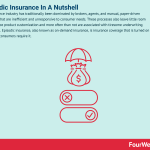
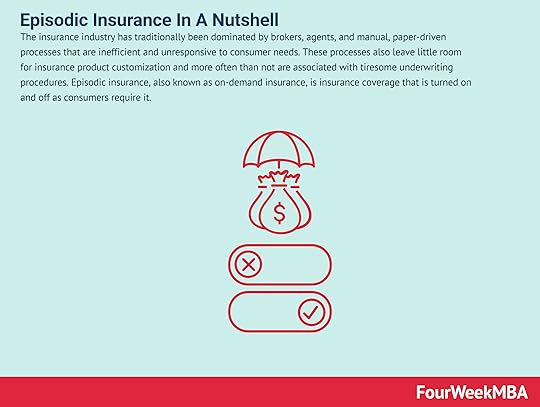
The insurance industry has traditionally been dominated by brokers, agents, and manual, paper-driven processes that are inefficient and unresponsive to consumer needs. These processes also leave little room for insurance product customization and more often than not are associated with tiresome underwriting procedures. Episodic insurance, also known as on-demand insurance, is insurance coverage that is turned on and off as consumers require it.
Understanding episodic insuranceWith digitization revolutionizing similarly archaic sectors such as real estate and banking, consumers now expect the insurance industry to follow suit by offering on-demand insurance coverage that is both seamless and convenient to obtain.
Insurtech companies have responded to the call for on-demand insurance by utilizing a range of technologies including the Internet of Things (IoT), blockchain, mobile sensors, artificial intelligence, and other interactive processes.
Episodic insurance is just one aspect of this new era, enabling consumers to purchase insurance cover on their smartphones as and when it is required without interacting with a broker or company representative. In general, there are no long-term contracts, and premiums are paid for within the app. Claims, on the other hand, are handled in a mobile chat interface.
Episodic insurance characteristicsFundamentally speaking, episodic insurance companies must provide a seamless customer experience while also making rapid and accurate risk assessments.
This dual ability requires capabilities such as:
Multi-channel data collection – insurers must collect data from IoT devices and connected technologies such as telematics, smartphone sensors, and wearables. Detailed data on insurance coverage duration and risk is then used to determine the premium that should be charged. For example, the premium a drone pilot is charged may depend on how fast or high they tend to fly their drone.Continuous data analytics – on occasion, episodic insurance will require continuous underwriting as the risk profile of the coverage changes. One example is usage-based vehicle insurance, where premiums are determined by driving behavior and how many miles are driven over a set period.Customer-centric product design – traditional insurance companies have a tendency to be inflexible and insure consumers in areas they didn’t request. Episodic insurance, on the other hand, covers consumers for exactly what they need and nothing more. Episodic insurance typesWhile episodic insurance is a relatively recent development, several types are already being utilized. These include:
Continuous underwriting – where the risk profile of the individual, business, or asset being insured is constantly updated. As noted earlier, this has been made possible by advances in IoT devices.Sharing economy insurance – this form of episodic insurance covers the risks and liabilities that are specific to an asset that is shared. Companies such as Airbnb (homes), Lyft (rides), and Task Rabbit (skills) are prime examples.Microinsurance – which is intended to cover smaller or time-specific events and occasions. Many examples of microinsurance predate episodic insurance as we understand it today. Travel insurance is one example, where a traveler protects against theft or sickness over the course of their vacation. Coverage for a one-time rental of expensive assets is another example, such as a wedding photographer taking out cover for the use of a high-value lens for the weekend.Key takeaways:Episodic insurance, also known as on-demand insurance, is insurance coverage that is turned on and off as consumers require it. Like other industries with traditional and archaic practices, the insurance industry has been made more efficient by IoT devices and artificial intelligence.Episodic insurance characteristics include multi-channel data collection, continuous data analytics, and customer-centric product design.Episodic insurance is a relative newcomer to the insurance industry. Three types have started to emerge: continuous underwriting, sharing economy insurance, and microinsurance.Read Next: Next Insurance Business Model.
Main Free Guides:
Business ModelsBusiness CompetitionBusiness StrategyBusiness DevelopmentDigital Business ModelsDistribution ChannelsMarketing StrategyPlatform Business ModelsRevenue ModelsTech Business ModelsBlockchain Business Models FrameworkThe post What Is Episodic Insurance? Episodic Insurance In A Nutshell appeared first on FourWeekMBA.
What Is Social Marketing? Social Marketing In A Nutshell
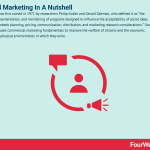
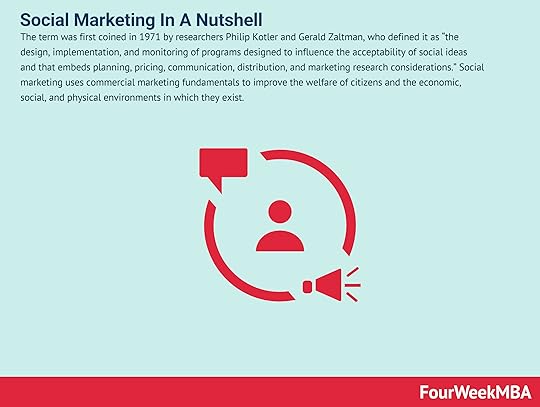
The term was first coined in 1971 by researchers Philip Kotler and Gerald Zaltman, who defined it as “the design, implementation, and monitoring of programs designed to influence the acceptability of social ideas and that embeds planning, pricing, communication, distribution, and marketing research considerations.” Social marketing uses commercial marketing fundamentals to improve the welfare of citizens and the economic, social, and physical environments in which they exist.
Understanding social marketingSocial marketing is a broad and diverse field that applies commercial marketing principles to the creation, communication, and delivery of value to benefit individuals and society as a whole.
Social marketing is typically described in the context of the 4 Ps of marketing:
Product – in social marketing, the product is a shift in attitude or a behavior change. Price – in other words, what is the cost of implementing those changes? Since it is hard to place a dollar value on the cost of a social initiative, social marketing endeavors to reframe a change in behavior or attitude as more beneficial than maintaining the status quo.Place – or the location where a target audience can be reached and the product distributed. Social marketing makes this process as effortless as possible to maximize the uptake of a change.Promotion – to be widely successful, social initiatives must be promoted across the community and reinforced via multiple channels.The five components of social marketingSocial marketing campaigns comprise the following five components:
1 – Instituting behavioral changeIn a traditional marketing situation, teams understand that awareness of a product or service in isolation does not guarantee the consumer will purchase. Similarly, changes in knowledge or attitude do not guarantee that a behavioral change has been made in a social marketing effort.
To that end, social marketers want to see the target audience perform one of four actions:
Accept a new behavior. For example, start a recycling habit.Reject a potential behavior. For example, the avoidance of smoking or speeding.Modify a current behavior, such as working out for two hours instead of one.Abandon an old behavior, such as using a smartphone while driving. 2 – Change is usually voluntaryVoluntary change is at the core of social marketing. Campaigns focus on showing a level of understanding and empathy for the audience that helps them discover the personal benefits of changing a behavior on their own.
3 – Marketing principles and techniquesSocial marketing campaigns must also appeal to the motivations of the individual to prevent injury, protect the environment, increase public health, or make positive contributions to communities.
To achieve this, research into what the individual currently knows, does, and believes is critical.
4 – Identify a target audienceAs in a traditional marketing campaign, customer segments in social marketing must also be targeted based on specific characteristics. Each individual has a unique combination of needs, wants, aspirations, and values that must be considered.
5 – Individuals, groups, and societies are beneficiariesSocial marketing seeks to institute change on the individual level by increasing quality of life. Society as a whole then benefits from a healthier population that is also more productive.
Social marketing examplesBelow is a brief look at a few real-world social marketing campaigns:
Animal crueltyTo educate consumers about harmful practices against geese, animal protection organization Gaia marketed a product called Faux Gras as a vegetarian and more humane alternative to foie gras.
Wildfire preventionIn the United States, Smokey The Bear is a mascot that educates individuals about fire safety and wildfire prevention. Smokey’s friendly and approachable persona is used to mobilize American citizens toward a collective effort to save their environment.
Lung disease preventionTo reduce the prevalence of chronic obstructive pulmonary disease (COPD), British health authorities created segments of high-risk individuals according to their age, social and environmental factors, job status, motivation to change, and social group. The result of the campaign was a quick reference risk model that helped health planners and key personnel understand that a one-size-fits-all approach to reducing COPD was ineffective.
Key takeaways:Social marketing uses commercial marketing fundamentals to improve the welfare of citizens and the economic, social, and physical environments in which they exist.Social marketing is based on the 4 Ps of a marketing mix: product, price, promotion, and place. The approach also understands that changes in knowledge or attitude among the target audience do not guarantee that a behavioral change has taken place.Social marketing is used in a range of social initiatives, including animal cruelty protection, wildfire prevention, and reducing the prevalence of lung disease.Main Free Guides:
Business ModelsBusiness CompetitionBusiness StrategyBusiness DevelopmentDigital Business ModelsDistribution ChannelsMarketing StrategyPlatform Business ModelsRevenue ModelsTech Business ModelsBlockchain Business Models FrameworkConnected Business Concepts Content marketing is one of the most powerful commercial activities which focuses on leveraging content production (text, audio, video, or other formats) to attract a targeted audience. Content marketing focuses on building a strong brand, but also to convert part of that targeted audience into potential customers.
Content marketing is one of the most powerful commercial activities which focuses on leveraging content production (text, audio, video, or other formats) to attract a targeted audience. Content marketing focuses on building a strong brand, but also to convert part of that targeted audience into potential customers.
 Integrated marketing describes the process of delivering consistent and relevant content to a target audience across all marketing channels. It is a cohesive, unified, and immersive marketing strategy that is cost-effective and relies on brand identity and storytelling to amplify the brand to a wider and wider audience.
Integrated marketing describes the process of delivering consistent and relevant content to a target audience across all marketing channels. It is a cohesive, unified, and immersive marketing strategy that is cost-effective and relies on brand identity and storytelling to amplify the brand to a wider and wider audience.
 Grassroots marketing involves a brand creating highly targeted content for a particular niche or audience. When an organization engages in grassroots marketing, it focuses on a small group of people with the hope that its marketing message is shared with a progressively larger audience.
Grassroots marketing involves a brand creating highly targeted content for a particular niche or audience. When an organization engages in grassroots marketing, it focuses on a small group of people with the hope that its marketing message is shared with a progressively larger audience.
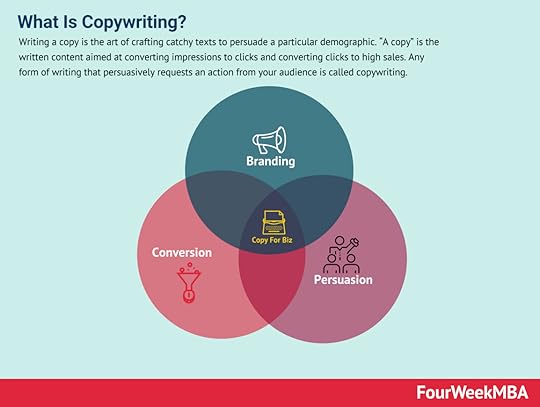 Writing a copy is the art of crafting catchy texts to persuade a particular demographic. “A copy” is the written content aimed at converting impressions to clicks and converting clicks to high sales. Any form of writing that persuasively requests an action from your audience is called copywriting.
Writing a copy is the art of crafting catchy texts to persuade a particular demographic. “A copy” is the written content aimed at converting impressions to clicks and converting clicks to high sales. Any form of writing that persuasively requests an action from your audience is called copywriting.
 Buzz marketing leverages the power of word-of-mouth advertising to create products or services with enough novelty that they go viral. In many cases, buzz marketing leverages on versatile content that can easily scale and be readapted to various contexts and fear of missing out (FOMO) to amplify the effect of word-of-mouth campaigns.
Buzz marketing leverages the power of word-of-mouth advertising to create products or services with enough novelty that they go viral. In many cases, buzz marketing leverages on versatile content that can easily scale and be readapted to various contexts and fear of missing out (FOMO) to amplify the effect of word-of-mouth campaigns.
 Inbound marketing is a marketing strategy designed to attract customers to a brand with content and experiences that they derive value from. Inbound marketing utilizes blogs, events, SEO, and social media to create brand awareness and attract targeted consumers. By attracting or “drawing in” a targeted audience, inbound marketing differs from outbound marketing which actively pushes a brand onto consumers who may have no interest in what is being offered.
Inbound marketing is a marketing strategy designed to attract customers to a brand with content and experiences that they derive value from. Inbound marketing utilizes blogs, events, SEO, and social media to create brand awareness and attract targeted consumers. By attracting or “drawing in” a targeted audience, inbound marketing differs from outbound marketing which actively pushes a brand onto consumers who may have no interest in what is being offered.
 Binge-watching is the practice of watching TV series all at once. In a speech at the Edinburgh Television Festival in 2013, Kevin Spacey said: “If they want to binge then we should let them binge.” This new content format would be popularized by Netflix, launching its TV series all at once.
Binge-watching is the practice of watching TV series all at once. In a speech at the Edinburgh Television Festival in 2013, Kevin Spacey said: “If they want to binge then we should let them binge.” This new content format would be popularized by Netflix, launching its TV series all at once.The post What Is Social Marketing? Social Marketing In A Nutshell appeared first on FourWeekMBA.
What Is The Scarcity Principle? Scarcity Principle In A Nutshell
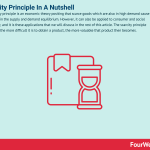

The scarcity principle is an economic theory positing that scarce goods which are also in high demand cause an imbalance in the supply and demand equilibrium. However, it can also be applied to consumer and social psychology, and it is these applications that we will discuss in the rest of this article. The scarcity principle posits that the more difficult it is to obtain a product, the more valuable that product then becomes.
Understanding the scarcity principleWith that said, the scarcity principle states that consumers value something more if it is scarce. A similar definition was provided by author Robert B. Cialdini in his acclaimed book Influence: The Psychology of Persuasion. He noted that “opportunities seem more valuable to us when their availability is limited.”
In the context of consumer purchase behavior, the scarcity principle is a motivator. Since consumers believe the scarce product will soon become unavailable, they value it more and are more likely to purchase it when compared to a situation where the product is abundant. Armed with this knowledge, brands use the scarcity principle to manipulate consumers into purchasing their products.
Why is the scarcity principle effective?Cialdini suggests there are two main drivers of the scarcity principle.
1 – Consumers create mental short-cuts to deal with a complex worldOtherwise known as heuristics, these mental-short cuts are used to estimate the value of an item based on its scarcity. Rare items that are difficult to obtain are assumed to be worth more than abundant items that are easier to obtain.
This heuristic is valid most of the time, but in some cases, it is invalid.
2 – Scarcity limits opportunities, which reduces the freedom to chooseFor better or worse, humans evolved to react when freedom of choice is limited or reduced. This is a survival instinct stemming from the fact that the impact of a loss is more severe than the impact of a comparable gain.
As a result, consumers are always on the lookout for potential losses and are hardwired to keep their options open. Fewer options mean less freedom of choice and the risk that as resources become less available, they may not be available at all in the future.
Whenever freedom of choice is threatened, the need for the consumer to retain their freedom makes them desire the product even more. As access to a product is threatened, in other words, the consumer makes a concerted and vigorous effort to possess that product.
Examples of brands that used the scarcity principleLet’s conclude this article by having a look at some case studies where the scarcity principle has been used effectively:
Nintendo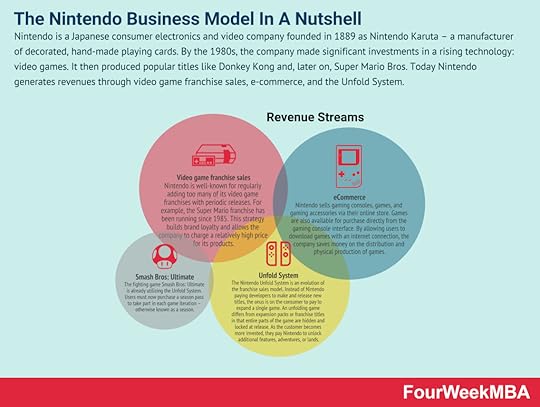 Nintendo is a Japanese consumer electronics and video company founded in 1889 as Nintendo Karuta – a manufacturer of decorated, hand-made playing cards. By the 1980s, the company made significant investments in a rising technology: video games. It then produced popular titles like Donkey Kong and, later on, Super Mario Bros. Today Nintendo generates revenues through video game franchise sales, e-commerce, and the Unfold System.
Nintendo is a Japanese consumer electronics and video company founded in 1889 as Nintendo Karuta – a manufacturer of decorated, hand-made playing cards. By the 1980s, the company made significant investments in a rising technology: video games. It then produced popular titles like Donkey Kong and, later on, Super Mario Bros. Today Nintendo generates revenues through video game franchise sales, e-commerce, and the Unfold System.When the Wii was released in 2006, mass hysteria ensued as consumers clamored to purchase one. This continued for three years before the supply was comparable to demand.
To increase scarcity, Nintendo capped production volume over that period and advised consumers to “stalk the UPS driver” to determine when a new shipment of Wiis was about to be delivered.
Starbucks Starbucks is a retail company that sells beverages (primarily consisting of coffee-related drinks) and food. In 2018, Starbucks had 52% of company-operated stores vs. 48% of licensed stores. The revenues for company-operated stores accounted for 80% of total revenues, thus making Starbucks a chain business model.
Starbucks is a retail company that sells beverages (primarily consisting of coffee-related drinks) and food. In 2018, Starbucks had 52% of company-operated stores vs. 48% of licensed stores. The revenues for company-operated stores accounted for 80% of total revenues, thus making Starbucks a chain business model. The coffee chain announced the Unicorn Frappuccino in April 2017 via an Instagram post with the caption “Available for a limited time at participating stores in the US, Canada & Mexico.”
The hashtag #unicornfrappuccino was posted nearly 160,000 times in response to the perceived value of the novel, time-limited beverage.
Groupon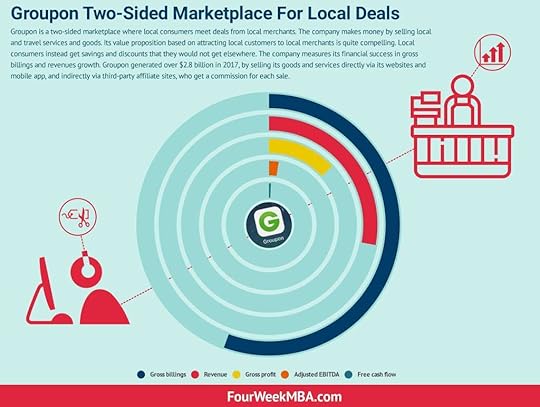 Groupon is a two-sided marketplace where local consumers meet deals from local merchants. The company makes money by selling local and travel services and goods. Its value proposition based on attracting local customers to local merchants is quite compelling. Local consumers instead get savings and discounts that they would not get elsewhere. The company measures its financial success in gross billings and revenues growth. Groupon generated over $2.8 billion in 2017, by selling its goods and services directly via its websites and mobile app, and indirectly via third-party affiliate sites, who get a commission for each sale.
Groupon is a two-sided marketplace where local consumers meet deals from local merchants. The company makes money by selling local and travel services and goods. Its value proposition based on attracting local customers to local merchants is quite compelling. Local consumers instead get savings and discounts that they would not get elsewhere. The company measures its financial success in gross billings and revenues growth. Groupon generated over $2.8 billion in 2017, by selling its goods and services directly via its websites and mobile app, and indirectly via third-party affiliate sites, who get a commission for each sale.Discount service platform Groupon is a master of using the scarcity principle to persuade consumers to take advantage of its offers.
Like Starbucks, scarcity is created because each deal is available for a limited time only. Groupon uses social proof as an extra motivator, displaying the number of consumers who have purchased the deal and rated it highly. Humans interpret scarcity combined with social proof to mean that the product must be worth having since most others appear to be purchasing it.
Booking.com Booking Holdings is the company the controls six main brands that comprise Booking.com, priceline.com, KAYAK, agoda.com, Rentalcars.com, and OpenTable. Over 76% of the company revenues in 2017 came primarily via travel reservations commisions and travel insurance fees. Almost 17% came from merchant fees, and the remaining revenues came from advertising earned via KAYAK. As distribution strategy, the company spent over $4.5 billion in performance-based and brand advertising.
Booking Holdings is the company the controls six main brands that comprise Booking.com, priceline.com, KAYAK, agoda.com, Rentalcars.com, and OpenTable. Over 76% of the company revenues in 2017 came primarily via travel reservations commisions and travel insurance fees. Almost 17% came from merchant fees, and the remaining revenues came from advertising earned via KAYAK. As distribution strategy, the company spent over $4.5 billion in performance-based and brand advertising. Online reservation platform Booking.com allows users to book a range of accommodations including hotels, apartments, holiday homes, and motels.
For applicable properties, Booking.com shows the number of rooms left with additional text highlighted in red such as “Only 2 rooms left at this price on our site” or “3 other people looked for your dates in the last 24 hours”.
Key takeaways:The scarcity principle posits that the more difficult a product is to obtain, the more valuable that product then becomes. In the context of consumer behavior, the scarcity principle motivates the consumer to purchase.The scarcity principle is caused by consumers creating heuristics in an attempt to value items accurately. Scarcity also reduces freedom of choice which causes the individual to desire the product even more.The scarcity principle has been used by many brands to successfully market their products. These include Starbucks, Groupon, Nintendo, and Booking.com.Main Free Guides:
Business ModelsBusiness CompetitionBusiness StrategyBusiness DevelopmentDigital Business ModelsDistribution ChannelsMarketing StrategyPlatform Business ModelsRevenue ModelsTech Business ModelsBlockchain Business Models FrameworkConnected Business Concepts Content marketing is one of the most powerful commercial activities which focuses on leveraging content production (text, audio, video, or other formats) to attract a targeted audience. Content marketing focuses on building a strong brand, but also to convert part of that targeted audience into potential customers.
Content marketing is one of the most powerful commercial activities which focuses on leveraging content production (text, audio, video, or other formats) to attract a targeted audience. Content marketing focuses on building a strong brand, but also to convert part of that targeted audience into potential customers.
 Integrated marketing describes the process of delivering consistent and relevant content to a target audience across all marketing channels. It is a cohesive, unified, and immersive marketing strategy that is cost-effective and relies on brand identity and storytelling to amplify the brand to a wider and wider audience.
Integrated marketing describes the process of delivering consistent and relevant content to a target audience across all marketing channels. It is a cohesive, unified, and immersive marketing strategy that is cost-effective and relies on brand identity and storytelling to amplify the brand to a wider and wider audience.
 Grassroots marketing involves a brand creating highly targeted content for a particular niche or audience. When an organization engages in grassroots marketing, it focuses on a small group of people with the hope that its marketing message is shared with a progressively larger audience.
Grassroots marketing involves a brand creating highly targeted content for a particular niche or audience. When an organization engages in grassroots marketing, it focuses on a small group of people with the hope that its marketing message is shared with a progressively larger audience.
 Writing a copy is the art of crafting catchy texts to persuade a particular demographic. “A copy” is the written content aimed at converting impressions to clicks and converting clicks to high sales. Any form of writing that persuasively requests an action from your audience is called copywriting.
Writing a copy is the art of crafting catchy texts to persuade a particular demographic. “A copy” is the written content aimed at converting impressions to clicks and converting clicks to high sales. Any form of writing that persuasively requests an action from your audience is called copywriting.
 Buzz marketing leverages the power of word-of-mouth advertising to create products or services with enough novelty that they go viral. In many cases, buzz marketing leverages on versatile content that can easily scale and be readapted to various contexts and fear of missing out (FOMO) to amplify the effect of word-of-mouth campaigns.
Buzz marketing leverages the power of word-of-mouth advertising to create products or services with enough novelty that they go viral. In many cases, buzz marketing leverages on versatile content that can easily scale and be readapted to various contexts and fear of missing out (FOMO) to amplify the effect of word-of-mouth campaigns.
 Inbound marketing is a marketing strategy designed to attract customers to a brand with content and experiences that they derive value from. Inbound marketing utilizes blogs, events, SEO, and social media to create brand awareness and attract targeted consumers. By attracting or “drawing in” a targeted audience, inbound marketing differs from outbound marketing which actively pushes a brand onto consumers who may have no interest in what is being offered.
Inbound marketing is a marketing strategy designed to attract customers to a brand with content and experiences that they derive value from. Inbound marketing utilizes blogs, events, SEO, and social media to create brand awareness and attract targeted consumers. By attracting or “drawing in” a targeted audience, inbound marketing differs from outbound marketing which actively pushes a brand onto consumers who may have no interest in what is being offered.
 Binge-watching is the practice of watching TV series all at once. In a speech at the Edinburgh Television Festival in 2013, Kevin Spacey said: “If they want to binge then we should let them binge.” This new content format would be popularized by Netflix, launching its TV series all at once.
Binge-watching is the practice of watching TV series all at once. In a speech at the Edinburgh Television Festival in 2013, Kevin Spacey said: “If they want to binge then we should let them binge.” This new content format would be popularized by Netflix, launching its TV series all at once.The post What Is The Scarcity Principle? Scarcity Principle In A Nutshell appeared first on FourWeekMBA.
How to make money with NFTs
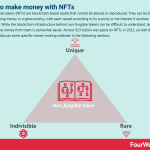

Non-fungible tokens (NFTs) are blockchain-based assets that cannot be altered or reproduced. They can be bought and sold using money or cryptocurrency, with each valued according to its scarcity or the interest it receives from consumers. While the blockchain infrastructure behind non-fungible tokens can be difficult to understand, learning how to make money from them is somewhat easier. Almost $13 billion was spent on NFTs in 2021, so with that in mind, let’s discuss some specific money-making methods in the following sections.
NFT tradingSome make money with NFTs by purchasing them at a low price and then selling them for a profit. American art collector Pablo Rodriguez-Fraile purchased a piece of art for $66.666.66 and then sold it four months later in February 2021 for $6.6 million. The piece of art, comprised of a 10-second video clip, was created by renowned artist Beeple – a graphic designer also known as Michael Winkelmann.
Similar to selling shares for a profit, the NFT trader must understand what they are buying and any prevailing market sentiment around the token. They will also need to factor in certain costs such as gas fees, listing fees, and any royalties that need to be paid to the owner.
Digital artAs you may have noticed in the previous section, NFTs based on digital works of art are some of the most valuable ever created. Another of Beeple’s works of art sold for $69 million in the first-ever NFT auction held at Christie’s. The work itself is a collage of Winkelmann’s first 5000 days of work, starting from crude sketches and then evolving into digital shapes and sceneries.
NFTs guarantee ownership and authenticity, which makes it a revolutionary technology for digital art creators.
Video games NFT games are those that incorporate non-fungible tokens (NFT) as a way to drive growth. In essence, NFT games enable developers to monetize their creations while giving users the ability to earn cryptocurrency just by playing the game, what’s known as the play-to-earn business model.
NFT games are those that incorporate non-fungible tokens (NFT) as a way to drive growth. In essence, NFT games enable developers to monetize their creations while giving users the ability to earn cryptocurrency just by playing the game, what’s known as the play-to-earn business model.It is also possible to make money from video game NFTs. This is a match made in heaven since many video games were already monetising in-game collectibles before NFTs were developed. Indeed, players of titles such as World of Warcraft and Counter-Strike spend vast amounts of money on virtual items that enhance gameplay.
Like other NFT types, video game NFTs can be sold in a marketplace to other players.
Licensed collectiblesLicensed collectibles encompass a variety of NFTs, including sports trading cards, trinkets, and memorabilia. The most popular collectibles are sports cards, with Deloitte predicting that NFT sports media sales will exceed $2 billion in 2022.
For example, the NBA established an online NFT marketplace in 2020 where basketball fans could trade officially licensed virtual clips of their favorite players. Other sports governing bodies are likely to follow suit, with NFT platform Opensea selling collectibles in Formula 1 racing, NFL, golf, and baseball.
In any case, note that most physical items can be turned into a licensed collectible NFT.
Investing in NFT companiesInvesting in the NFT companies themselves is also a viable way to make money. If nothing else, NFTs have proven that they are not a fad and increased investment has fuelled rapid growth in the industry as a result.
NFT collectibles and games are popular at the present moment, but there exists a diverse range of startups for the interested investor.
Key takeaways:Non-fungible tokens (NFTs) are blockchain-based assets that cannot be altered or reproduced. They can be bought and sold using money or cryptocurrency, with each valued according to its scarcity or level of consumer interest.Traders make money on NFTs by purchasing NFTs and then selling them for a profit. Others use the inherent authenticity and proof of ownership of NFTs to sell their digital artworks.Licensed collectibles are also a way to make money from NFTs, with sports player cards one of the most popular ways to make money in licensed marketplaces. NFT startup companies are also a source of revenue as the industry experiences rapid growth and innovation.Get The 450 Pages Blockchain Business Models Book

Read Also: Gaming Industry, Epic Games Business Model, Free-To-Play, Proof-of-stake, Proof-of-work, Bitcoin, Dogecoin, Ethereum, Solana, Blockchain, BAT, Monero, Ripple, Litecoin, Stellar, Dogecoin, Bitcoin Cash, Filecoin.
Main Free Guides:
Business ModelsBusiness StrategyBusiness DevelopmentDigital Business ModelsDistribution ChannelsMarketing StrategyPlatform Business ModelsRevenue ModelsTech Business ModelsBlockchain Business Models FrameworkConnected Business Concepts EA Sports is among the largest gaming publishers, with a hybrid strategy of fully-owned games and licensed games distributed with a cross-platform approach. FIFA is the game that most contributes to its revenues and live services (Ultimate Team in particular) are the largest revenue contributors to EA revenues.
EA Sports is among the largest gaming publishers, with a hybrid strategy of fully-owned games and licensed games distributed with a cross-platform approach. FIFA is the game that most contributes to its revenues and live services (Ultimate Team in particular) are the largest revenue contributors to EA revenues. The gaming industry, part of the entertainment industry, is comprised of three main types of players. From game engines, which help developers build their games. To publishing gaming houses. And gaming consoles. While the prevailing business model for decades has been that of selling the console at cost, and make money on games. Digital games changed the way games are distributed and sold, and it opened up the way to free-to-play models.
The gaming industry, part of the entertainment industry, is comprised of three main types of players. From game engines, which help developers build their games. To publishing gaming houses. And gaming consoles. While the prevailing business model for decades has been that of selling the console at cost, and make money on games. Digital games changed the way games are distributed and sold, and it opened up the way to free-to-play models. Roblox is an online gaming platform where users can create avatars and explore various gaming experiences. Each experience will be monetized based on how its developer has structured the game. For instance, free games allow users to spend the platform’s currency, called Robux, to get specific enhancements or purchase items like clothing accessories for the avatars, simulated gestures from the Roblox Avatar Marketplace. Therefore, Roblox makes money by earning a commission on each transaction and through its internal ad network.
Roblox is an online gaming platform where users can create avatars and explore various gaming experiences. Each experience will be monetized based on how its developer has structured the game. For instance, free games allow users to spend the platform’s currency, called Robux, to get specific enhancements or purchase items like clothing accessories for the avatars, simulated gestures from the Roblox Avatar Marketplace. Therefore, Roblox makes money by earning a commission on each transaction and through its internal ad network. Tencent is a Chinese multinational conglomerate founded in 1998 by Ma Huateng, Zhang Zhidong, and Xu Chenye. Among its various global subsidiaries are companies in the online services, music, and artificial intelligence industries. But it is perhaps best known for its interest in the video game sector – both as a game developer for the Chinese market and the acquirer of several established gaming companies. Tencent is a vast company with a stake in more than 600 companies. Following is a look at some of the companies and subsidiaries it has a majority stake in.
Tencent is a Chinese multinational conglomerate founded in 1998 by Ma Huateng, Zhang Zhidong, and Xu Chenye. Among its various global subsidiaries are companies in the online services, music, and artificial intelligence industries. But it is perhaps best known for its interest in the video game sector – both as a game developer for the Chinese market and the acquirer of several established gaming companies. Tencent is a vast company with a stake in more than 600 companies. Following is a look at some of the companies and subsidiaries it has a majority stake in. A free-to-play is a model that became particularly popular in gaming. Free-to-play is also commonly referred to as free-to-start. For instance, companies like Epic Games have launched popular games like Fortnite’s Battle Royale, which had ingrained a free-to-play model. This is a model that become extremely popular in the digital age of gaming.
A free-to-play is a model that became particularly popular in gaming. Free-to-play is also commonly referred to as free-to-start. For instance, companies like Epic Games have launched popular games like Fortnite’s Battle Royale, which had ingrained a free-to-play model. This is a model that become extremely popular in the digital age of gaming. According to Joel Monegro, a former analyst at USV (a venture capital firm) the blockchain implies value creation in its protocols. Where the web has allowed the value to be captured at the applications layer (take Facebook, Twitter, Google, and many others). In a Blockchain Economy, this value might be captured by the protocols at the base of the blockchain (for instance Bitcoin and Ethereum). However, according to blockchain investor Paivinen due to ease of forking, incentives to compete and improved interoperability and interchangeability also in a blockchain-based economy, protocols might get thinner. Although the marginal value of scale might be lower compared to a web-based economy, where massive scale created an economic advantage. The success of the Blockchain will depend on its commercial viability!
According to Joel Monegro, a former analyst at USV (a venture capital firm) the blockchain implies value creation in its protocols. Where the web has allowed the value to be captured at the applications layer (take Facebook, Twitter, Google, and many others). In a Blockchain Economy, this value might be captured by the protocols at the base of the blockchain (for instance Bitcoin and Ethereum). However, according to blockchain investor Paivinen due to ease of forking, incentives to compete and improved interoperability and interchangeability also in a blockchain-based economy, protocols might get thinner. Although the marginal value of scale might be lower compared to a web-based economy, where massive scale created an economic advantage. The success of the Blockchain will depend on its commercial viability! A Proof of Stake (PoS) is a form of consensus algorithm used to achieve agreement across a distributed network. As such it is, together with Proof of Work, among the key consensus algorithms for Blockchain protocols (like the Ethereum’s Casper protocol). Proof of Stake has the advantage of security, reduced risk of centralization, and energy efficiency.
A Proof of Stake (PoS) is a form of consensus algorithm used to achieve agreement across a distributed network. As such it is, together with Proof of Work, among the key consensus algorithms for Blockchain protocols (like the Ethereum’s Casper protocol). Proof of Stake has the advantage of security, reduced risk of centralization, and energy efficiency. A Proof of Work is a form of consensus algorithm used to achieve agreement across a distributed network. In a Proof of Work, miners compete to complete transactions on the network, by commuting hard mathematical problems (i.e. hashes functions) and as a result they get rewarded in coins.
A Proof of Work is a form of consensus algorithm used to achieve agreement across a distributed network. In a Proof of Work, miners compete to complete transactions on the network, by commuting hard mathematical problems (i.e. hashes functions) and as a result they get rewarded in coins. Non-fungible tokens (NFTs) are cryptographic tokens that represent something unique. Non-fungible assets are those that are not mutually interchangeable. Non-fungible tokens contain identifying information that makes them unique. Unlike Bitcoin – which has a supply of 21 million identical coins – they cannot be exchanged like for like.
Non-fungible tokens (NFTs) are cryptographic tokens that represent something unique. Non-fungible assets are those that are not mutually interchangeable. Non-fungible tokens contain identifying information that makes them unique. Unlike Bitcoin – which has a supply of 21 million identical coins – they cannot be exchanged like for like. A Blockchain Business Model according to the FourWeekMBA framework is made of four main components: Value Model (Core Philosophy, Core Values and Value Propositions for the key stakeholders), Blockchain Model (Protocol Rules, Network Shape and Applications Layer/Ecosystem), Distribution Model (the key channels amplifying the protocol and its communities), and the Economic Model (the dynamics/incentives through which protocol players make money). Those elements coming together can serve as the basis to build and analyze a solid Blockchain Business Model.
A Blockchain Business Model according to the FourWeekMBA framework is made of four main components: Value Model (Core Philosophy, Core Values and Value Propositions for the key stakeholders), Blockchain Model (Protocol Rules, Network Shape and Applications Layer/Ecosystem), Distribution Model (the key channels amplifying the protocol and its communities), and the Economic Model (the dynamics/incentives through which protocol players make money). Those elements coming together can serve as the basis to build and analyze a solid Blockchain Business Model. Ethereum was launched in 2015 with its cryptocurrency, Ether, as an open-source, blockchain-based, decentralized platform software. Smart contracts are enabled, and Distributed Applications (dApps) get built without downtime or third-party disturbance. It also helps developers build and publish applications as it is also a programming language running on a blockchain.
Ethereum was launched in 2015 with its cryptocurrency, Ether, as an open-source, blockchain-based, decentralized platform software. Smart contracts are enabled, and Distributed Applications (dApps) get built without downtime or third-party disturbance. It also helps developers build and publish applications as it is also a programming language running on a blockchain.The post How to make money with NFTs appeared first on FourWeekMBA.
Types of entrepreneurship
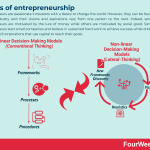

Entrepreneurs are passionate innovators with a desire to change the world. However, they can be found in any industry and their visions and aspirations vary from one person to the next. Indeed, some entrepreneurs are motivated by the lure of money while others are motivated by social good. Some entrepreneurs start small companies and believe in sustained hard work to achieve success while others are a part of corporations that use capital to reach their goals.
Social entrepreneurshipThe main goal of social entrepreneurship is to improve society in some shape or form. While some of these companies exist to make money, there are also non-profits and B Corps that balance social purpose with profit.
Warby Parker is one example of social entrepreneurship, with the company donating more than eight million pairs of glasses to disadvantaged citizens who are vision-impaired.
Innovation entrepreneurshipInnovation entrepreneurship is the transformation of an invention or idea into a business venture. This entrepreneurship type seeks to change the way people live in a manner that no other company has managed to do.
Elon Musk, Steve Jobs, and Bill Gates are all examples of motivated, passionate innovation entrepreneurs whose companies redefined what was thought possible.
Small business entrepreneurshipSmall business entrepreneurship describes modest innovation that tends to be the result of adding a new twist to an existing product or service. Profits from these innovations are used to meet payroll or support basic living expenses. In other words, they are not reinvested to expand the business.
As the name suggests, small business entrepreneurship is found in many mom-and-pop businesses such as hairdressers, butchers, grocery stores, florists, and consultants.
Hustler entrepreneurshipHustlers are those who believe in the power of hard work sustained over a long period. They have grand visions to grow the company into something more substantial and are not afraid to take risks.
One example of hustler entrepreneurship is Mary Kay Ash, founder of the beauty company Mary Kay Cosmetics. Ash used a combination of confidence, conscientiousness, extroversion, and superior networking skills to make her dream a reality.
Imitator entrepreneurshipIn a similar way to small business entrepreneurs, imitators consider what is already working and then develop a product, service, or business model that is innovative or iterative. They can spot the mistakes others have made and improve on them with self-confidence and conviction.
Many believe imitator entrepreneurship to be a blend of innovators and hustlers. Facebook CEO Mark Zuckerberg is one such example.
Researcher entrepreneurshipResearcher entrepreneurs favor practicality over innovation and will spend vast amounts of time analyzing data to reduce the chances of a venture failing. Researchers possess exemplary critical thinking and problem-solving skills and have a strong desire for order. They make sure they understand every aspect of a business and a driven by logic rather than emotion.
Larry Ellison, a businessman, and co-founder of Oracle Corporation is a good example of researcher entrepreneurship.
Key takeaways:Entrepreneurs are passionate innovators with a desire to change the world. They can be found in almost any industry and the visions and aspirations vary from one entrepreneur to the next.Social entrepreneurship seeks to improve society in some way, while innovation entrepreneurship takes a new idea and makes it viable.Small business entrepreneurship is commonly found in mom-and-pop stores where the primary goal is to support a basic but comfortable existence. Hustler entrepreneurs believe success is down to sustained hard work, while researcher entrepreneurship is practical, analytical, and driven by logic instead of emotion.Business Model Frameworks for EntrepreneursFourWeekMBA Business Model Framework A business model is a framework for finding a systematic way to unlock long-term value for an organization while delivering value to customers and capturing value through monetization strategies. A business model is a holistic framework to understand, design, and test your business assumptions in the marketplace.VTDF Tech Business Model Framework
A business model is a framework for finding a systematic way to unlock long-term value for an organization while delivering value to customers and capturing value through monetization strategies. A business model is a holistic framework to understand, design, and test your business assumptions in the marketplace.VTDF Tech Business Model Framework A tech business model is made of four main components: value model (value propositions, mission, vision), technological model (R&D management), distribution model (sales and marketing organizational structure), and financial model (revenue modeling, cost structure, profitability and cash generation/management). Those elements coming together can serve as the basis to build a solid tech business model.Business Model Canvas
A tech business model is made of four main components: value model (value propositions, mission, vision), technological model (R&D management), distribution model (sales and marketing organizational structure), and financial model (revenue modeling, cost structure, profitability and cash generation/management). Those elements coming together can serve as the basis to build a solid tech business model.Business Model Canvas The business model canvas is a framework proposed by Alexander Osterwalder and Yves Pigneur in Busines Model Generation enabling the design of business models through nine building blocks comprising: key partners, key activities, value propositions, customer relationships, customer segments, critical resources, channels, cost structure, and revenue streams.Lean Startup Canvas
The business model canvas is a framework proposed by Alexander Osterwalder and Yves Pigneur in Busines Model Generation enabling the design of business models through nine building blocks comprising: key partners, key activities, value propositions, customer relationships, customer segments, critical resources, channels, cost structure, and revenue streams.Lean Startup Canvas The lean startup canvas is an adaptation by Ash Maurya of the business model canvas by Alexander Osterwalder, which adds a layer that focuses on problems, solutions, key metrics, unfair advantage based, and a unique value proposition. Thus, starting from mastering the problem rather than the solution.Blitzscaling Canvas
The lean startup canvas is an adaptation by Ash Maurya of the business model canvas by Alexander Osterwalder, which adds a layer that focuses on problems, solutions, key metrics, unfair advantage based, and a unique value proposition. Thus, starting from mastering the problem rather than the solution.Blitzscaling Canvas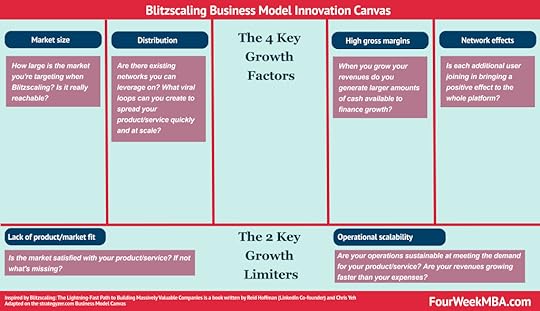 The Blitzscaling business model canvas is a model based on the concept of Blitzscaling, which is a particular process of massive growth under uncertainty, and that prioritizes speed over efficiency and focuses on market domination to create a first-scaler advantage in a scenario of uncertainty.Business Model Wheel
The Blitzscaling business model canvas is a model based on the concept of Blitzscaling, which is a particular process of massive growth under uncertainty, and that prioritizes speed over efficiency and focuses on market domination to create a first-scaler advantage in a scenario of uncertainty.Business Model Wheel A business model wheel provides a structured approach to defining a business model. Each model wheel is broken down into three core components: offering, monetization, and sustainability. Each component in turn contributes to a total of eight areas that make up an ideal business model.Business Model Innovation Framework
A business model wheel provides a structured approach to defining a business model. Each model wheel is broken down into three core components: offering, monetization, and sustainability. Each component in turn contributes to a total of eight areas that make up an ideal business model.Business Model Innovation Framework Business model innovation is about increasing the success of an organization with existing products and technologies by crafting a compelling value proposition able to propel a new business model to scale up customers and create a lasting competitive advantage. And it all starts by mastering the key customers.3C Business Model Analysis
Business model innovation is about increasing the success of an organization with existing products and technologies by crafting a compelling value proposition able to propel a new business model to scale up customers and create a lasting competitive advantage. And it all starts by mastering the key customers.3C Business Model Analysis The 3C Analysis Business Model was developed by Japanese business strategist Kenichi Ohmae. A 3C Model is a marketing tool that focuses on customers, competitors, and the company. At the intersection of these three variables lies an effective marketing strategy to gain a potential competitive advantage and build a lasting company.
The 3C Analysis Business Model was developed by Japanese business strategist Kenichi Ohmae. A 3C Model is a marketing tool that focuses on customers, competitors, and the company. At the intersection of these three variables lies an effective marketing strategy to gain a potential competitive advantage and build a lasting company.Main Free Guides:
Business ModelsBusiness CompetitionBusiness StrategyBusiness DevelopmentDigital Business ModelsDistribution ChannelsMarketing StrategyPlatform Business ModelsRevenue ModelsTech Business ModelsBlockchain Business Models FrameworkThe post Types of entrepreneurship appeared first on FourWeekMBA.
What Is Outside Sales? Outside Sales In A Nutshell
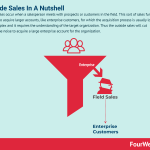

Outside sales occur when a salesperson meets with prospects or customers in the field. This sort of sales function is critical to acquire larger accounts, like enterprise customers, for which the acquisition process is usually longer, more complex and it requires the understanding of the target organization. Thus the outside sales will cut through the noise to acquire a large enterprise account for the organization.
Understanding outside salesOutside sales representatives conduct sales in the field via face-to-face interactions in a location convenient to the prospect or customer.
The work environment of an outside sales professional tends to be less formal and more autonomous since it is outside the confines of an office setting. While the attractiveness of increased freedom cannot be denied, it is important to note that outside sales reps may be required to work on-demand according to the client’s schedule. This often means ensuring they are available outside of normal work hours.
Each outside sales representative may have a territory assigned to them and be responsible for educating the prospect about a product or service. What’s more, they must make their own travel arrangements and be flexible to scheduling changes or delays. Unlike inside sales professionals, those in outside sales place more emphasis on their physical appearance and need to be in the mood to entertain and network whenever the need arises.
Responsibilities associated with outside salesHere is a more succinct look at the responsibilities associated with the outside sales profession:
Establish and nurture business relationships through regular meetings.Demonstrate the suitability of a product or service vis-à-vis solving customer problems. This can be done with presentations, hands-on tutorials, and case studies.Set and achieve monthly sales quotas.Attend events, conferences, and conventions to present a product to service to interested parties.Monitor the market for new entrants that could become competitors.Map the various locations of clients using an app for territory and customer mapping.Set up sales appointments using mobile CRM tools or by visiting prospects in person.Research a prospect’s pain points in advance or be able to determine them from face-to-face interaction.Utilize an outside sales app to keep a record of all customers, sales, hours worked, and generate reports based on tasks assigned and tasks completed.Manage expenses associated with car rental, airline tickets, accommodation, and client entertainment such as restaurants and sporting events.What traits does an outside sales rep need to possess?At the very least, an outside sales rep needs to possess a Bachelor’s degree in communications, business, economics, or marketing. Similar qualifications that show experience in customer engagement may also be adequate.
They must also have a strong phone presence and be confident initiating conversations with prospects. Since no day in outside sales is the same as the last, the individual must also be adept at problem-solving in a diverse range of contexts.
Some of the more obvious traits include strong interpersonal skills, extraversion, detail-orientation, and the motivation and discipline necessary to work autonomously.
Key takeaways:Outside sales occur when a salesperson meets with prospects or customers in the field.Responsibilities associated with outside sales include the ability to build relationships, demonstrate products, attend events and conventions, monitor the market for new entrants, and map the location of customers in a sales territory.Outside sales require the individual to possess a strong phone presence and be able to problem-solve in diverse contexts. A Bachelor’s degree in communications, business, economics, marketing, or similar is essential.Related Business Concepts Business development comprises a set of strategies and actions to grow a business via a mixture of sales, marketing, and distribution. While marketing usually relies on automation to reach a wider audience, and sales typically leverage on a one-to-one approach. The business development’s role is that of generating distribution.
Business development comprises a set of strategies and actions to grow a business via a mixture of sales, marketing, and distribution. While marketing usually relies on automation to reach a wider audience, and sales typically leverage on a one-to-one approach. The business development’s role is that of generating distribution. The more you move from consumers to enterprise clients, the more you’ll need a sales force able to manage complex sales. As a rule of thumb, a more expensive product, in B2B or Enterprise, will require an organizational structure around sales. An inexpensive product to be offered to consumers will leverage on marketing.
The more you move from consumers to enterprise clients, the more you’ll need a sales force able to manage complex sales. As a rule of thumb, a more expensive product, in B2B or Enterprise, will require an organizational structure around sales. An inexpensive product to be offered to consumers will leverage on marketing.
 Content marketing is one of the most powerful commercial activities which focuses on leveraging content production (text, audio, video, or other formats) to attract a targeted audience. Content marketing focuses on building a strong brand, but also to convert part of that targeted audience into potential customers.
Content marketing is one of the most powerful commercial activities which focuses on leveraging content production (text, audio, video, or other formats) to attract a targeted audience. Content marketing focuses on building a strong brand, but also to convert part of that targeted audience into potential customers.
 Integrated marketing describes the process of delivering consistent and relevant content to a target audience across all marketing channels. It is a cohesive, unified, and immersive marketing strategy that is cost-effective and relies on brand identity and storytelling to amplify the brand to a wider and wider audience.
Integrated marketing describes the process of delivering consistent and relevant content to a target audience across all marketing channels. It is a cohesive, unified, and immersive marketing strategy that is cost-effective and relies on brand identity and storytelling to amplify the brand to a wider and wider audience.
 Grassroots marketing involves a brand creating highly targeted content for a particular niche or audience. When an organization engages in grassroots marketing, it focuses on a small group of people with the hope that its marketing message is shared with a progressively larger audience.
Grassroots marketing involves a brand creating highly targeted content for a particular niche or audience. When an organization engages in grassroots marketing, it focuses on a small group of people with the hope that its marketing message is shared with a progressively larger audience.
 Writing a copy is the art of crafting catchy texts to persuade a particular demographic. “A copy” is the written content aimed at converting impressions to clicks and converting clicks to high sales. Any form of writing that persuasively requests an action from your audience is called copywriting.
Writing a copy is the art of crafting catchy texts to persuade a particular demographic. “A copy” is the written content aimed at converting impressions to clicks and converting clicks to high sales. Any form of writing that persuasively requests an action from your audience is called copywriting.
 Buzz marketing leverages the power of word-of-mouth advertising to create products or services with enough novelty that they go viral. In many cases, buzz marketing leverages on versatile content that can easily scale and be readapted to various contexts and fear of missing out (FOMO) to amplify the effect of word-of-mouth campaigns.
Buzz marketing leverages the power of word-of-mouth advertising to create products or services with enough novelty that they go viral. In many cases, buzz marketing leverages on versatile content that can easily scale and be readapted to various contexts and fear of missing out (FOMO) to amplify the effect of word-of-mouth campaigns.
 Inbound marketing is a marketing strategy designed to attract customers to a brand with content and experiences that they derive value from. Inbound marketing utilizes blogs, events, SEO, and social media to create brand awareness and attract targeted consumers. By attracting or “drawing in” a targeted audience, inbound marketing differs from outbound marketing which actively pushes a brand onto consumers who may have no interest in what is being offered.
Inbound marketing is a marketing strategy designed to attract customers to a brand with content and experiences that they derive value from. Inbound marketing utilizes blogs, events, SEO, and social media to create brand awareness and attract targeted consumers. By attracting or “drawing in” a targeted audience, inbound marketing differs from outbound marketing which actively pushes a brand onto consumers who may have no interest in what is being offered.
 Binge-watching is the practice of watching TV series all at once. In a speech at the Edinburgh Television Festival in 2013, Kevin Spacey said: “If they want to binge then we should let them binge.” This new content format would be popularized by Netflix, launching its TV series all at once.
Binge-watching is the practice of watching TV series all at once. In a speech at the Edinburgh Television Festival in 2013, Kevin Spacey said: “If they want to binge then we should let them binge.” This new content format would be popularized by Netflix, launching its TV series all at once.Main Free Guides:
Business ModelsBusiness CompetitionBusiness StrategyBusiness DevelopmentDigital Business ModelsDistribution ChannelsMarketing StrategyPlatform Business ModelsRevenue ModelsTech Business ModelsBlockchain Business Models FrameworkThe post What Is Outside Sales? Outside Sales In A Nutshell appeared first on FourWeekMBA.
January 22, 2022
Storytelling Examples
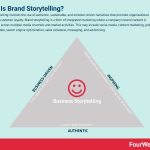

Every action that is performed by a business has an underlying narrative, whether those actions be related to the brand, customers, advocates, employees, or stakeholders.
Storytelling is a process where a narrative is created to allow a business to share its values, experiences, and history with the desired target audience. A connection is formed with the business when the audience can relate to some aspect of the business’s story in a way that is personal, emotional, and meaningful.
Businesses use these connections to foster brand loyalty among consumers, among many other applications. To get an appreciation for the power of storytelling in business, consider the following examples.
Formula 1The Formula One World Championship is to most people a simple story about winners and losers. However, marketers realized that this story was too familiar and failed to engage fans beyond the race itself.
To broaden the appeal of the sport, a Netflix documentary series was released with behind-the-scenes footage of the interactions between various drivers, teams, and the FIA throughout a season. The series, which was titled Drive to Survive, was praised for its ability to give context to storylines that were often formed while the competitors were not racing.
This series was also a hit with viewers. According to data released by ESPN, viewership for the 2021 season was 53% higher than it was for 2020.
Patagonia Patagonia is an American clothing retailer founded by climbing enthusiast Yvon Chouinard in 1973 who saw initial success by selling reusable climbing pitons and Scottish rugby shirts. Over time Patagonia also became a fashionable brand also for its focus on slow fashion. Indeed, the company sells high-priced clothing items built to last which it will repair for free.
Patagonia is an American clothing retailer founded by climbing enthusiast Yvon Chouinard in 1973 who saw initial success by selling reusable climbing pitons and Scottish rugby shirts. Over time Patagonia also became a fashionable brand also for its focus on slow fashion. Indeed, the company sells high-priced clothing items built to last which it will repair for free.Outdoor adventure brand Patagonia is also a master storyteller. The audacious “Don’t Buy This Jacket” campaign saw the company encouraging its customers not to buy Patagonia products unless they really needed to replace an old item.
Six years after that campaign was released, the company announced it would be suing Donald Trump after he reduced the size of public land in Utah by almost 2 million acres.
Both initiatives invited consumers with similar values to become part of the Patagonia story as a brand that advocates environmentalism, sustainability, and anti-consumerism.
TD BankCanadian financial institution TD Bank released a content hub called TD Stories, where employee stories are skillfully tied to the company’s mission.
During November, the hub features the stories of employees with a military background to recognize National Veterans and Military Families Month. These stories are aligned with the company’s mission to build communities where active and former military personnel can share their experiences, advance their careers, and promote awareness of veteran matters to colleagues and customers.
Rather than use storytelling to pitch to sales executives or the end-user, TD Bank collaborated with employees in customer-facing roles so consumers could relate to the company they do business in a meaningful way.
HuckberryHuckberry is an eCommerce company selling outdoor gear with a community of over 1 million active and adventurous consumers.
To promote its products, the company shares the stories of brand ambassadors on its blog. In one such story, ambassador Ben O’Meara wore Huckberry’s “72-Hour Merino Tee” for exactly 72 hours as he traveled across the Canadian wilderness by car and canoe.
O’ Meara camped in the beautiful Canadian wilderness and spent his time making photographs punctuated with visits to different breweries. This was the sort of vacation that is extremely attractive to Huckberry’s core audience of adventure lovers. While the company likely sold a fair few merino shirts as a result of the initiative, perhaps the greater value came from the opportunity to strengthen the relationship with its community through stories underpinned by shared values and experiences.
Key takeaways:Every action performed by a business has an underlying narrative, whether those actions be related to the brand, customers, advocates, employees, or stakeholders.Formula 1 released a behind-the-scenes documentary series after it realized the winner and loser narrative in each race was tired and one-dimensional. The series gave more context to the stories behind the sport, which increased engagement and viewership.Patagonia tells brand stories that appear to be counterintuitive to making a profit. However, it uses storytelling to attract consumers who share its strict environmental stance. TD Bank and Huckberry also used storytelling to align with their respective military and adventure-driven missions.Main Free Guides:
Business ModelsBusiness CompetitionBusiness StrategyBusiness DevelopmentDigital Business ModelsDistribution ChannelsMarketing StrategyPlatform Business ModelsRevenue ModelsTech Business ModelsBlockchain Business Models FrameworkConnected Business Concepts Content marketing is one of the most powerful commercial activities which focuses on leveraging content production (text, audio, video, or other formats) to attract a targeted audience. Content marketing focuses on building a strong brand, but also to convert part of that targeted audience into potential customers.
Content marketing is one of the most powerful commercial activities which focuses on leveraging content production (text, audio, video, or other formats) to attract a targeted audience. Content marketing focuses on building a strong brand, but also to convert part of that targeted audience into potential customers.
 Integrated marketing describes the process of delivering consistent and relevant content to a target audience across all marketing channels. It is a cohesive, unified, and immersive marketing strategy that is cost-effective and relies on brand identity and storytelling to amplify the brand to a wider and wider audience.
Integrated marketing describes the process of delivering consistent and relevant content to a target audience across all marketing channels. It is a cohesive, unified, and immersive marketing strategy that is cost-effective and relies on brand identity and storytelling to amplify the brand to a wider and wider audience.
 Grassroots marketing involves a brand creating highly targeted content for a particular niche or audience. When an organization engages in grassroots marketing, it focuses on a small group of people with the hope that its marketing message is shared with a progressively larger audience.
Grassroots marketing involves a brand creating highly targeted content for a particular niche or audience. When an organization engages in grassroots marketing, it focuses on a small group of people with the hope that its marketing message is shared with a progressively larger audience.
 Writing a copy is the art of crafting catchy texts to persuade a particular demographic. “A copy” is the written content aimed at converting impressions to clicks and converting clicks to high sales. Any form of writing that persuasively requests an action from your audience is called copywriting.
Writing a copy is the art of crafting catchy texts to persuade a particular demographic. “A copy” is the written content aimed at converting impressions to clicks and converting clicks to high sales. Any form of writing that persuasively requests an action from your audience is called copywriting.
 Buzz marketing leverages the power of word-of-mouth advertising to create products or services with enough novelty that they go viral. In many cases, buzz marketing leverages on versatile content that can easily scale and be readapted to various contexts and fear of missing out (FOMO) to amplify the effect of word-of-mouth campaigns.
Buzz marketing leverages the power of word-of-mouth advertising to create products or services with enough novelty that they go viral. In many cases, buzz marketing leverages on versatile content that can easily scale and be readapted to various contexts and fear of missing out (FOMO) to amplify the effect of word-of-mouth campaigns.
 Inbound marketing is a marketing strategy designed to attract customers to a brand with content and experiences that they derive value from. Inbound marketing utilizes blogs, events, SEO, and social media to create brand awareness and attract targeted consumers. By attracting or “drawing in” a targeted audience, inbound marketing differs from outbound marketing which actively pushes a brand onto consumers who may have no interest in what is being offered.
Inbound marketing is a marketing strategy designed to attract customers to a brand with content and experiences that they derive value from. Inbound marketing utilizes blogs, events, SEO, and social media to create brand awareness and attract targeted consumers. By attracting or “drawing in” a targeted audience, inbound marketing differs from outbound marketing which actively pushes a brand onto consumers who may have no interest in what is being offered.
 Binge-watching is the practice of watching TV series all at once. In a speech at the Edinburgh Television Festival in 2013, Kevin Spacey said: “If they want to binge then we should let them binge.” This new content format would be popularized by Netflix, launching its TV series all at once.
Binge-watching is the practice of watching TV series all at once. In a speech at the Edinburgh Television Festival in 2013, Kevin Spacey said: “If they want to binge then we should let them binge.” This new content format would be popularized by Netflix, launching its TV series all at once.The post Storytelling Examples appeared first on FourWeekMBA.
What Is Brand Storytelling? Brand Storytelling In A Nutshell
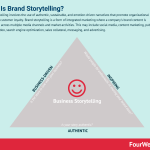

Brand storytelling involves the use of authentic, sustainable, and emotion-driven narratives that promote organizational growth and customer loyalty. Brand storytelling is a form of integrated marketing where a company’s brand content is streamlined across multiple media channels and market activities. This may include social media, content marketing, public relations, video, search engine optimization, sales collateral, messaging, and advertising.
Understanding brand storytellingBrand storytelling is a sustainable way to communicate a brand based on the stories a company shares and the stories others share about the company based on its behaviors or actions. It’s important to note that brand storytelling does not encompass a company logo, catchphrase, timeline, or advertising commercial. Nor does it solely encompass the mission, vision, and values stated on the company website.
Instead, think of brand storytelling as the amalgamation of:
What a company stands for and what drives it toward success. What differentiates the company from its competitors.A company’s values, beliefs, and attitudes that comprise corporate culture.A company’s history, failures, successes, reasons for being and the individuals responsible for playing a significant role.The most skillful brand storytellers strike the right balance between commercial objectives – such as increasing brand awareness or revenue – and an audience-centric approach to the story itself.
Brand storytelling has become more popular in recent times as consumers actively avoid traditional advertising methods that are disruptive and repetitive. To that end, brands are now creating media content that is also entertaining and informative to appeal to the discerning consumer.
The foundational elements of brand storytellingIn truth, there are many approaches to telling brand stories that will resonate with consumers. Having said that, it is a good idea to incorporate the following foundational elements and then customize the narrative to suit the individual brand:
Plot and conflict – first, identify the antagonist who establishes a conflict and a protagonist that seeks to resolve it.Characters – the antagonist and protagonist should be “built out” with character depth to allow consumers to become emotionally invested. This causes them to cheer for the good guy and admonish the bad guy.Setting – the setting establishes the mood, influences character behavior, reveals conflict, and, in theory, elicits an emotional response in the consumer.Theme – in other words, what is the purpose of the story? If a business does not understand why it is telling a story, there is no chance the story will have its intended purpose. Form – or the medium with which the story will be told. These days, there are many options such as podcasts, webinars, spoken, video testimonials and success stories, animation, film, magazines, blog posts, articles, and social media content.Brand storytelling and the marketing funnel The sales funnel is a model used in marketing to represent an ideal, potential journey that potential customers go through before becoming actual customers. As a representation, it is also often an approximation, that helps marketing and sales teams structure their processes at scale, thus building repeatable sales and marketing tactics to convert customers.
The sales funnel is a model used in marketing to represent an ideal, potential journey that potential customers go through before becoming actual customers. As a representation, it is also often an approximation, that helps marketing and sales teams structure their processes at scale, thus building repeatable sales and marketing tactics to convert customers.Most businesses tell stories to influence consumer behavior. To do this effectively, brand storytelling should be in harmony with the four stages of a typical marketing funnel and the customer journey. This assumes the business has already identified a unique value proposition and has a detailed understanding of its target audience.
Let’s take a look at the four stages below. At each stage, the business should be telling stories that are relatable to the consumer in terms of their unique pains, struggles, or goals.
 AIDA stands for attention, interest, desire, and action. That is a model that is used in marketing to describe the potential journey a customer might go through before purchasing a product or service. The AIDA model helps organizations focus their efforts when optimizing their marketing activities based on the customers’ journeys. 1 – Awareness (build intrigue)
AIDA stands for attention, interest, desire, and action. That is a model that is used in marketing to describe the potential journey a customer might go through before purchasing a product or service. The AIDA model helps organizations focus their efforts when optimizing their marketing activities based on the customers’ journeys. 1 – Awareness (build intrigue)In the awareness stage, it is important to mention shared values and interests. In other words, what can the business say about its passions, problems, or experiences to make consumers feel like it understands them?
Investment platform Wealthsimple featured the story of a customer who was saddled with debt in its digital magazine. Since the customer was someone the company’s target audience could relate to, the brand was able to build authority and intrigue about how their debt was reduced.
2 – Consideration (educate and inform)In the consideration stage, the business should provide additional information to describe how it came to be founded and how it seeks to remedy the problems identified in the awareness stage.
Practical information that teaches, motivates, or engages is the most effective.
3 – Conversion (influence a purchase)Now it is time to detail how the business can actually solve the problem. Customer stories and their associated social proof build credibility and trust. Ideally, these stories should clarify whether the product or service does what it says on the box. They should also describe its competitive advantage and why the customer should care.
Some brands also use customer testimonials to focus on emotional impact over product features. For example, Google featured a goat farming couple who had increased their milk sales by 6000% in four years using Google Ads. Instead of focusing on the features within the ad platform that were responsible for the success, Google painted it as a typical “rags to riches” story where the farmers started with a single goat and grew their flock to over 70.
4 – Retention (inspire engagement)Customer retention is one of the most important metrics of any business. Here, it is important to share experiences that turn customers into fans and make them feel part of something special. The most adept marketing teams also realize that consumers are predisposed to making connections and attachments with others of a similar ilk.
To take advantage of this predisposition, Patagonia tells different stories that are segmented by the various preferences of their audience to make them feel like they belong, For example, the brand has devoted a section of its website to a place where climbers can come together and share stories, tips, and equipment reviews.
Key takeaways:Brand storytelling involves the use of authentic, sustainable, and emotion-driven narratives that promote organizational growth and customer loyalty.Brand storytelling endeavors to strike the right balance between commercial objectives and an audience-centric approach to the story itself. The foundational elements of a compelling story can be used to design strategies that attract consumers who are now averse to disruptive forms of marketing and advertising.Brand storytelling is used to influence consumer behavior. This can be done by telling stories across the four-stages of the marketing funnel that includes awareness, consideration, conversion, and retention.Main Free Guides:
Business ModelsBusiness CompetitionBusiness StrategyBusiness DevelopmentDigital Business ModelsDistribution ChannelsMarketing StrategyPlatform Business ModelsRevenue ModelsTech Business ModelsBlockchain Business Models FrameworkConnected Business Concepts Content marketing is one of the most powerful commercial activities which focuses on leveraging content production (text, audio, video, or other formats) to attract a targeted audience. Content marketing focuses on building a strong brand, but also to convert part of that targeted audience into potential customers.
Content marketing is one of the most powerful commercial activities which focuses on leveraging content production (text, audio, video, or other formats) to attract a targeted audience. Content marketing focuses on building a strong brand, but also to convert part of that targeted audience into potential customers.
 Integrated marketing describes the process of delivering consistent and relevant content to a target audience across all marketing channels. It is a cohesive, unified, and immersive marketing strategy that is cost-effective and relies on brand identity and storytelling to amplify the brand to a wider and wider audience.
Integrated marketing describes the process of delivering consistent and relevant content to a target audience across all marketing channels. It is a cohesive, unified, and immersive marketing strategy that is cost-effective and relies on brand identity and storytelling to amplify the brand to a wider and wider audience.
 Grassroots marketing involves a brand creating highly targeted content for a particular niche or audience. When an organization engages in grassroots marketing, it focuses on a small group of people with the hope that its marketing message is shared with a progressively larger audience.
Grassroots marketing involves a brand creating highly targeted content for a particular niche or audience. When an organization engages in grassroots marketing, it focuses on a small group of people with the hope that its marketing message is shared with a progressively larger audience.
 Writing a copy is the art of crafting catchy texts to persuade a particular demographic. “A copy” is the written content aimed at converting impressions to clicks and converting clicks to high sales. Any form of writing that persuasively requests an action from your audience is called copywriting.
Writing a copy is the art of crafting catchy texts to persuade a particular demographic. “A copy” is the written content aimed at converting impressions to clicks and converting clicks to high sales. Any form of writing that persuasively requests an action from your audience is called copywriting.
 Buzz marketing leverages the power of word-of-mouth advertising to create products or services with enough novelty that they go viral. In many cases, buzz marketing leverages on versatile content that can easily scale and be readapted to various contexts and fear of missing out (FOMO) to amplify the effect of word-of-mouth campaigns.
Buzz marketing leverages the power of word-of-mouth advertising to create products or services with enough novelty that they go viral. In many cases, buzz marketing leverages on versatile content that can easily scale and be readapted to various contexts and fear of missing out (FOMO) to amplify the effect of word-of-mouth campaigns.
 Inbound marketing is a marketing strategy designed to attract customers to a brand with content and experiences that they derive value from. Inbound marketing utilizes blogs, events, SEO, and social media to create brand awareness and attract targeted consumers. By attracting or “drawing in” a targeted audience, inbound marketing differs from outbound marketing which actively pushes a brand onto consumers who may have no interest in what is being offered.
Inbound marketing is a marketing strategy designed to attract customers to a brand with content and experiences that they derive value from. Inbound marketing utilizes blogs, events, SEO, and social media to create brand awareness and attract targeted consumers. By attracting or “drawing in” a targeted audience, inbound marketing differs from outbound marketing which actively pushes a brand onto consumers who may have no interest in what is being offered.
 Binge-watching is the practice of watching TV series all at once. In a speech at the Edinburgh Television Festival in 2013, Kevin Spacey said: “If they want to binge then we should let them binge.” This new content format would be popularized by Netflix, launching its TV series all at once.
Binge-watching is the practice of watching TV series all at once. In a speech at the Edinburgh Television Festival in 2013, Kevin Spacey said: “If they want to binge then we should let them binge.” This new content format would be popularized by Netflix, launching its TV series all at once.The post What Is Brand Storytelling? Brand Storytelling In A Nutshell appeared first on FourWeekMBA.
January 19, 2022
Marketplace Business Models
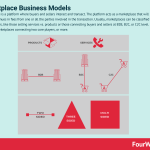

A marketplace is a platform where buyers and sellers interact and transact. The platform acts as a marketplace that will generate revenues in fees from one or all the parties involved in the transaction. Usually, marketplaces can be classified in several ways, like those selling services vs. products or those connecting buyers and sellers at B2B, B2C, or C2C level. And those marketplaces connecting two core players, or more.
Different types of marketplacesBased on the kind of thing sold on the marketplace we can break them down into:
Service.Products.Based on the nature of the people or companies interacting though the marketplace we can break them down into:
B2B.B2C. C2C.Based on the number of players interacting and transacting on the platform, marketplaces can be broken down into:
Two-sided.Three-sided.Multi-sided.Marketplaces case studiesEtsy’s product marketplace Etsy is a two-sided marketplace for unique and creative goods. As a marketplace, it makes money via transaction fees on the items sold on the platform. Etsy’s key partner is comprised of sellers providing unique listings, and a wide organic reach across several marketing channels. Uber Eats three-sided marketplace
Etsy is a two-sided marketplace for unique and creative goods. As a marketplace, it makes money via transaction fees on the items sold on the platform. Etsy’s key partner is comprised of sellers providing unique listings, and a wide organic reach across several marketing channels. Uber Eats three-sided marketplace Uber Eats is a three-sided marketplace connecting a driver, a restaurant owner, and a customer with the Uber Eats platform at the center. The three-sided marketplace moves around three players: Restaurants pay commission on the orders to Uber Eats; Customers pay the small delivery charges, and at times, cancellation fee; Drivers earn through making reliable deliveries on time.LinkedIn two-sided marketplace
Uber Eats is a three-sided marketplace connecting a driver, a restaurant owner, and a customer with the Uber Eats platform at the center. The three-sided marketplace moves around three players: Restaurants pay commission on the orders to Uber Eats; Customers pay the small delivery charges, and at times, cancellation fee; Drivers earn through making reliable deliveries on time.LinkedIn two-sided marketplace LinkedIn for Business is used on a very large scale, around 30 million+ brands and businesses are using it. LinkedIn marketing tools available for each business size and sort, from small to large and B2B to B2C. LinkedIn is the most effective marketing tool not only for salespeople but also for brands and to build a strong corporate brand.Other marketplace business model case studiesAmazon Business Model
LinkedIn for Business is used on a very large scale, around 30 million+ brands and businesses are using it. LinkedIn marketing tools available for each business size and sort, from small to large and B2B to B2C. LinkedIn is the most effective marketing tool not only for salespeople but also for brands and to build a strong corporate brand.Other marketplace business model case studiesAmazon Business Model Amazon has a diversified business model. In 2019 Amazon posted over $280 billion in revenues and over $11.5 billion in net profits. Online stores contributed to over 50% of Amazon revenues, followed by Physical Stores, Amazon AWS, Subscription Services, Third-party Seller Services, and Advertising revenues.Doordash Business Model
Amazon has a diversified business model. In 2019 Amazon posted over $280 billion in revenues and over $11.5 billion in net profits. Online stores contributed to over 50% of Amazon revenues, followed by Physical Stores, Amazon AWS, Subscription Services, Third-party Seller Services, and Advertising revenues.Doordash Business Model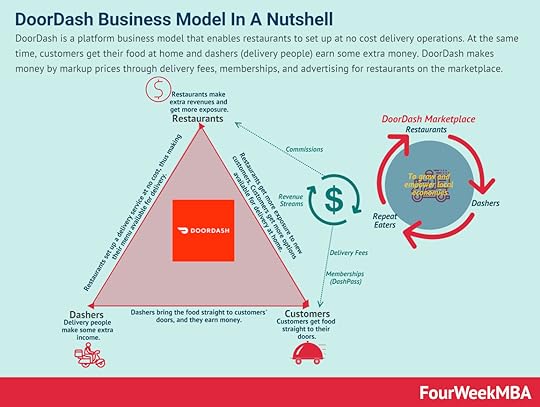 DoorDash is a platform business model that enables restaurants to set up at no cost delivery operations. At the same time, customers get their food at home and dashers (delivery people) earn some extra money. DoorDash makes money by markup prices through delivery fees, memberships, and advertising for restaurants on the marketplace.Etsy Business Model
DoorDash is a platform business model that enables restaurants to set up at no cost delivery operations. At the same time, customers get their food at home and dashers (delivery people) earn some extra money. DoorDash makes money by markup prices through delivery fees, memberships, and advertising for restaurants on the marketplace.Etsy Business Model Etsy is a two-sided marketplace for unique and creative goods. As a marketplace, it makes money via transaction fees on the items sold on the platform. Etsy’s key partner is comprised of sellers providing unique listings, and a wide organic reach across several marketing channels.Uber Business Model
Etsy is a two-sided marketplace for unique and creative goods. As a marketplace, it makes money via transaction fees on the items sold on the platform. Etsy’s key partner is comprised of sellers providing unique listings, and a wide organic reach across several marketing channels.Uber Business Model  Uber is a is two-sided marketplace, a platform business model that connects drivers and riders, with an interface that has elements of gamification, that makes it easy for two sides to connect and transact. Uber makes money by collecting fees from the platform’s gross bookings.Uber Eats Business Model
Uber is a is two-sided marketplace, a platform business model that connects drivers and riders, with an interface that has elements of gamification, that makes it easy for two sides to connect and transact. Uber makes money by collecting fees from the platform’s gross bookings.Uber Eats Business Model Uber Eats is a three-sided marketplace connecting a driver, a restaurant owner and a customer with Uber Eats platform at the center. The three-sided marketplace moves around three players: Restaurants pay commission on the orders to Uber Eats; Customers pay the small delivery charges, and at times, cancellation fee; Drivers earn through making reliable deliveries on time.
Uber Eats is a three-sided marketplace connecting a driver, a restaurant owner and a customer with Uber Eats platform at the center. The three-sided marketplace moves around three players: Restaurants pay commission on the orders to Uber Eats; Customers pay the small delivery charges, and at times, cancellation fee; Drivers earn through making reliable deliveries on time.Read More: Platform Business Models, Network Effects, Etsy Business Model, Uber Eats Business Model, LinkedIn Business Model, Virtuous Cycle.
Read Also:
Business Strategy ExamplesBusiness ModelsWhat Is a Value Proposition?Business Model InnovationDigital Business ModelsThe post Marketplace Business Models appeared first on FourWeekMBA.
Cloud Business Models
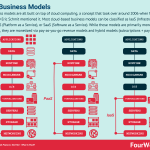

Cloud business models are all built on top of cloud computing, a concept that took over around 2006 when former Google’s CEO Eric Schmit mentioned it. Most cloud-based business models can be classified as IaaS (Infrastructure as a Service), PaaS (Platform as a Service), or SaaS (Software as a Service). While those models are primarily monetized via subscriptions, they are monetized via pay-as-you-go revenue models and hybrid models (subscriptions + pay-as-you-go).
Origin Story In 2006, the term “cloud computing” picked up, as tech giants like Amazon and Google were vastly investing in bringing applications on the web; with fast deployment and continuous updating, this model became viable not only at enterprise but also at the consumer level. And it gave birth to new business models built on top of the cloud, such as IaaS, PaaS, and SaaS
In 2006, the term “cloud computing” picked up, as tech giants like Amazon and Google were vastly investing in bringing applications on the web; with fast deployment and continuous updating, this model became viable not only at enterprise but also at the consumer level. And it gave birth to new business models built on top of the cloud, such as IaaS, PaaS, and SaaS (Image Source: Google Ngram)
Back in August 2006, at Search Engine Strategies Conference, in a conversation with Eric Schmidt hosted by Danny Sullivan, the former Google’s CEO pointed out,
What’s interesting [now] is that there is an emergent new model, and you all are here because you are part of that new model. I don’t think people have really understood how big this opportunity really is. It starts with the premise that the data services and architecture should be on servers. We call it cloud computing – they should be in a “cloud” somewhere. And that if you have the right kind of browser or the right kind of access, it doesn’t matter whether you have a PC or a Mac or a mobile phone or a BlackBerry or what have you – or new devices still to be developed – you can get access to the cloud. There are a number of companies that have benefited from that. Obviously, Google, Yahoo!, eBay, Amazon come to mind. The computation and the data and so forth are in the servers.
And he continued:
And so what’s interesting is that the two – “cloud computing and advertising – go hand-in-hand. There is a new business model that’s funding all of the software innovation to allow people to have platform choice, client choice, data architectures that are interesting, solutions that are new – and that’s being driven by advertising. The reason that I said “don’t bet against the Internet” is an awful lot of people are still trying to do stuff the old way. They’re still trying to build proprietary protocols, they’re still trying to not build standardized protocols. They’re still not trying to solve problems in a simple and extensible way. But when somebody does it right – let me give you the example of mashups, which are taking over the world by storm. It happens very fast. And that’s the power of the Internet.
While the term picked up traction from there, even though the term and potential of this technology were already understood in 1996, when a group of executives at Compaq already had forgone that most applications on the web of what they called “cloud computing-enabled applications.”
Even though, as we saw above, it would still take ten years, for this technology to pick up at scale. And by 2020, cloud computing would become one of the most profirable industries, and units of tech giants like Amazon (with AWS) Microsoft (with Azure), Google (with its Cloud), and IBM.
Not only that, cloud computing enabled the birth of an entrepreneurial ecosystem, and hundreds of companies, both in B2B and B2C that leveraged the cloud to build valuable products and services.
Consumers’ companies like Netflix, Spotify, YouTube are all built upon the cloud. Other enterprise-based organizations as well.
Classification of Cloud-Based Business ModelsCloud-based business models are usually classified as:
IaaS: in the infrastructure as a service, the cloud provider usually offers networking, storage, hosting, and virtualization. In this way, the customer can leverage a cloud-based infrastructure without building it internally, therefore avoiding the cost, complexity, and time required with that. In a way, the IaaS customer can leverage a complex infrastructure without building and maintaining it and using it on demand. PaaS: in the platform as a service, the cloud provider also offers the platform to build applications for customers/users. Therefore, users will have all the tools needed to build these applications. Also, the customer gets a whole set of tools on-demand, without having to build them, while the client will manage those applications and related data. SaaS: in the software as a service, the provider offers also applications and data management, so that the final customer can get service on demand. Technological InfrastructureDepending on the type of cloud-based business model, the company might have a complex or less technological infrastructure or platform. Perhaps, a SaaS service might well be built on top of existing IaaS and PaaS. Therefore, only do the part related to the UI and UX development for final users/customers.
Other cloud-based infrastructures can be extremely complex. Companies like Amazon AWS, Google Cloud, Microsoft Azure, and IBM Cloud (which are the major players) took years to develop and enabled an entrepreneurial ecosystem of companies built on top of them. A whole set of SaaS companies are built on top of those cloud providers.
Commercial Use CasesThe commercial use cases covered by cloud-based business models is vast. From B2B/Enterprise companies offering big data analysis, business intelligence, inventory management, and much more, to B2C companies offering streaming services, social media platforms and more to final customers.
Revenue ModelsWhile business models built on top of the cloud are usually driven by a subscription (as they run as an on-demand service), in reality there are several revenue streams used:
Subscription-based. Consumption-based (pay-as-you-go).Advertising-based.Hybrid models.Read More: IaaS vs PaaS vs SaaS
Connected Business Frameworks One of the first mentions of customer lifetime value was in the 1988 book Database Marketing: Strategy and Implementation written by Robert Shaw and Merlin Stone. Customer lifetime value (CLV) represents the value of a customer to a company over a period of time. It represents a critical business metric, especially for SaaS or recurring revenue-based businesses.
One of the first mentions of customer lifetime value was in the 1988 book Database Marketing: Strategy and Implementation written by Robert Shaw and Merlin Stone. Customer lifetime value (CLV) represents the value of a customer to a company over a period of time. It represents a critical business metric, especially for SaaS or recurring revenue-based businesses.  AIOps is the application of artificial intelligence to IT operations. It has become particularly useful for modern IT management in hybridized, distributed, and dynamic environments. AIOps has become a key operational component of modern digital-based organizations, built around software and algorithms.
AIOps is the application of artificial intelligence to IT operations. It has become particularly useful for modern IT management in hybridized, distributed, and dynamic environments. AIOps has become a key operational component of modern digital-based organizations, built around software and algorithms.  Machine Learning Ops (MLOps) describes a suite of best practices that successfully help a business run artificial intelligence. It consists of the skills, workflows, and processes to create, run, and maintain machine learning models to help various operational processes within organizations.
Machine Learning Ops (MLOps) describes a suite of best practices that successfully help a business run artificial intelligence. It consists of the skills, workflows, and processes to create, run, and maintain machine learning models to help various operational processes within organizations.  The business intelligence models have transitioned to continuous intelligence, where dynamic technology infrastructure is coupled with continuous deployment and delivery to provide continuous intelligence. In short, the software offered in the cloud will integrate with the company’s data, leveraging on AI/ML to provide answers in real-time to current issues the organization might be experiencing.
The business intelligence models have transitioned to continuous intelligence, where dynamic technology infrastructure is coupled with continuous deployment and delivery to provide continuous intelligence. In short, the software offered in the cloud will integrate with the company’s data, leveraging on AI/ML to provide answers in real-time to current issues the organization might be experiencing.  The business intelligence models have transitioned to continuous intelligence, where dynamic technology infrastructure is coupled with continuous deployment and delivery to provide continuous intelligence. In short, the software offered in the cloud will integrate with the company’s data, leveraging on AI/ML to provide answers in real-time to current issues the organization might be experiencing.
The business intelligence models have transitioned to continuous intelligence, where dynamic technology infrastructure is coupled with continuous deployment and delivery to provide continuous intelligence. In short, the software offered in the cloud will integrate with the company’s data, leveraging on AI/ML to provide answers in real-time to current issues the organization might be experiencing.  That is a process that requires a continuous feedback loop to develop a valuable product and build a viable business model. Continuous innovation is a mindset where products and services are designed and delivered to tune them around the customers’ problems and not the technical solution of its founders.
That is a process that requires a continuous feedback loop to develop a valuable product and build a viable business model. Continuous innovation is a mindset where products and services are designed and delivered to tune them around the customers’ problems and not the technical solution of its founders. Technological modeling is a discipline to provide the basis for companies to sustain innovation, thus developing incremental products. While also looking at breakthrough innovative products that can pave the way for long-term success. In a sort of Barbell Strategy, technological modeling suggests having a two-sided approach, on the one hand, to keep sustaining continuous innovation as a core part of the business model. On the other hand, it places bets on future developments that have the potential to break through and take a leap forward.
Technological modeling is a discipline to provide the basis for companies to sustain innovation, thus developing incremental products. While also looking at breakthrough innovative products that can pave the way for long-term success. In a sort of Barbell Strategy, technological modeling suggests having a two-sided approach, on the one hand, to keep sustaining continuous innovation as a core part of the business model. On the other hand, it places bets on future developments that have the potential to break through and take a leap forward. Read More:
Business ModelsBusiness StrategyMarketing StrategyBusiness Model InnovationPlatform Business ModelsNetwork Effects In A NutshellDigital Business ModelsThe post Cloud Business Models appeared first on FourWeekMBA.



